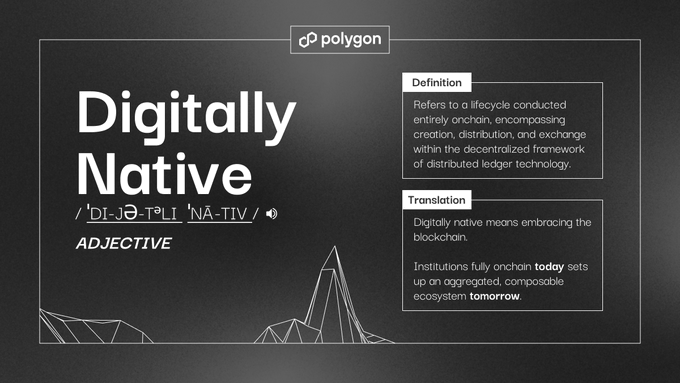Institutional Finance Embracing Blockchain Technology
Institutional Finance Embracing Blockchain Technology
🔑 Institutional Liquidity Unlocked?

Recent developments indicate a growing interest from institutional investors in tokenizing assets and conducting transactions on blockchain networks like Polygon. Major institutions such as Sygnum, Hamilton Lane, and Apex Global Group have launched tokenized funds worth billions of dollars on Polygon's Proof-of-Stake network. This shift towards digitally native finance allows institutions to tap into global liquidity pools and a composable ecosystem of financial products. By tokenizing shares and conducting transactions on-chain, institutions aim to achieve disintermediation, accessibility, and capital and operational efficiencies. This trend suggests that institutional finance is preparing to capitalize on the potential of blockchain technology for composable and aggregated financial products in the future.
Institutions are getting busy onchain. Why -- Digitally native institutional finance today, aggregated and composable on Polygon networks tomorrow. Let's start with a recap of the institutional adoption on Polygon PoS to date. (intern out)
Tokenization offers many things. Disintermediation, accessibility, capital and operational efficiencies. But a less discussed future state might present the biggest unlock of all - billions in institutional funds becoming liquid and composable. Composable institutional finance.
Historically, institutional developments with tokenized assets have taken place primarily offchain, where a fund is tokenized onchain but the subsequent shares are issued and exchanged via a traditional digital record. But institutional interest is shifting to digitally native.
🇮🇳 Indian Cities Go Onchain

**Indian institutions are moving critical records to Polygon blockchain** - **BBD University** in Lucknow digitized degrees, ID cards, and certificates - cutting verification errors in half and eliminating fraud - **Three cities** (Amravati, Solapur, Kalyan-Dombivali) moved citizen documents onchain - birth records, permits, tax docs now verify in minutes vs months - **Maharashtra forensic labs** replaced paper trails with blockchain evidence tracking - creating tamper-proof chain of custody - **Festivals and conferences** switched from weeks-long printing processes to instant QR verification The shift creates **transparent, auditable government records** while dramatically reducing costs and processing times.
Polymarket App Returns to US Market After Previous Exit

**Polymarket has officially relaunched** its application for US users, marking a significant return to the American prediction market space. The platform's comeback follows its earlier acquisition of derivatives exchange QCEX in July, which positioned the company for re-entry into the regulated US market. - **Direct access restored** for American users to trade on prediction markets - **Regulatory compliance** achieved through strategic acquisition approach - **Market expansion** signals growing acceptance of prediction market platforms This development represents a major milestone for decentralized prediction markets in the United States, where regulatory clarity has been a persistent challenge for crypto-based platforms.
Money Rails Buenos Aires Panel Recordings Now Available

**Money Rails Buenos Aires** panel recordings are now live on YouTube for those who missed the event. The one-day summit focused on: - Networking opportunities - Payment innovation discussions - Future of money insights - Web3 industry panels All sessions from the November 18 event have been compiled into a comprehensive playlist. [Watch the full Money Rails Buenos Aires playlist](https://www.youtube.com/playlist?list=PLslsfan1R_z33l-Wsa_PCkKzYWP8Ysb3c) Catch up on key discussions about payment systems and monetary innovation that you may have missed.
Brazil's Real Stablecoins Hit 50K Weekly Transactions on Polygon
**Brazilian Real-linked stablecoins** are gaining significant traction on Polygon, with over **50,000 transactions weekly**. The milestone reflects growing adoption of blockchain-based financial services in Brazil's market. Users can now access **onchain yield opportunities** denominated in Brazilian Reais. **Key developments:** - 50K+ BRL stablecoin transactions per week on Polygon - New yield-earning capabilities for Real-denominated assets - Growing bridge between traditional Brazilian finance and DeFi Brazil's high interest rate environment creates unique opportunities for onchain yield strategies, allowing users to earn returns while maintaining exposure to local currency.
Immutable Launches Polygon Gaming Hub with Five New Titles and 500 Gem Rewards
**Five new games** are now live on the Polygon Hub within Immutable Play, offering players up to **500 Gems per title** through quest completion. **Key Features:** - Dedicated gaming hub for Polygon-based titles - Quest system with gem rewards for each game - Additional prize pool for top performers - Part of Immutable x Polygon collaboration **Background Context:** This launch builds on the previously announced partnership between Immutable and Polygon Labs. The collaboration includes a **$100K reward pool** and plans for future Agglayer integration. Immutable Play already serves **250k+ monthly users** with **$40M TVL**, making it a significant platform for web3 gaming adoption. **What's Next:** Future updates will include native Agglayer integration for Immutable zkEVM, enabling **cross-chain gaming** and digital asset portability across connected chains. Players can start completing quests immediately to earn gems and compete for additional rewards from the prize pool.

